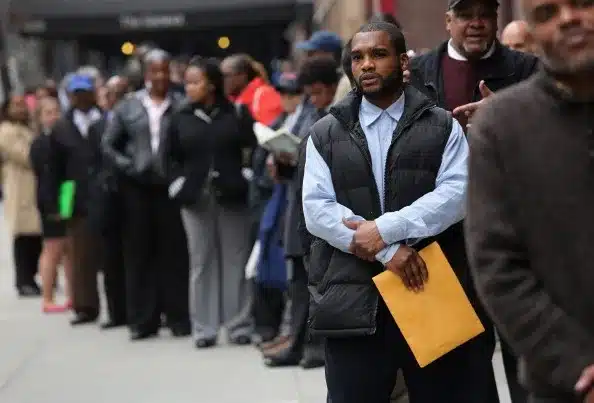Black American Unemployment Rate Hits Highest Level Since 2021 as Jobs Data Pattern Points to Recession

The U.S. economy added just 22,000 jobs in August while unemployment rose to 4.3%, marking a dramatic slowdown that has disproportionately impacted Black workers. Black unemployment surged to 7.5%—its highest level since October 2021—serving as what economists describe as a “canary in the coal mine” for broader economic troubles ahead.
Disproportionate Impact on Black Workers
The unemployment rate for Black Americans now stands at more than double the rate for white workers, reflecting persistent structural inequities in the labor market. Black women have been particularly hard hit, with their unemployment rate jumping from 5.4% in January to 6.7% in August—a 1.3 percentage point increase that far exceeds the 0.3 percentage point rise in overall unemployment during the same period.
Black men faced a 7.1% unemployment rate in August, while Black teenagers aged 16-19 experienced a staggering 24.8% unemployment rate, highlighting the severe challenges facing younger workers in the current economic climate.
Federal Job Cuts Drive Losses
A significant factor in rising Black unemployment has been the Trump administration’s reduction of the federal workforce, which has shed 97,000 jobs since January. Black workers comprise nearly 19% of federal employees, making them disproportionately vulnerable to government downsizing.
The cuts have particularly affected agencies where Black women represent substantial portions of the workforce, including USAID, the Consumer Financial Protection Bureau, and the Department of Education, where Black women made up 28% of workers. Overall, Black women constitute 12% of the federal workforce—nearly double their share in the broader labor force.
Economic Warning Signals
Economists view rising Black unemployment as an early indicator of broader economic deterioration. Gary Hoover, an economist at Tulane University, notes that unemployment rates for young people and Black workers, particularly Black men, typically serve as “a telltale sign of the direction of the economy and what we can expect to see hit overall in a few months.”
Gbenga Ajilore, chief economist at the Center on Budget and Policy Priorities, similarly describes Black unemployment as a “canary in the coal mine,” warning that steady increases “portends that the economy might be heading toward a downturn.”
Broader Labor Market Struggles
The concerning employment data extends beyond racial disparities. The U.S. economy added only 22,000 jobs in August, far below the anticipated 75,000, while the overall unemployment rate rose to 4.3%—its highest level since September 2017 outside the pandemic period.
Revised data revealed the economy actually lost 13,000 jobs in June, marking the first net job loss since 2020. More than one-quarter of unemployed workers have now been jobless for over six months, the highest proportion since June 2016.
Sector-Specific Challenges
Black workers face additional headwinds from industry-specific downturns. More than a quarter of Black men work in logistics and transportation—sectors experiencing increased unemployment amid economic uncertainty and potential tariff impacts on manufacturing and trade.
Joseph Dean, a research economist at the National Community Reinvestment Coalition, observes that “across the board, you’re seeing industries that employ large amounts of Black people either stagnant or in decline.”

Historical Context and Recovery Concerns
Black unemployment has historically exceeded rates for other racial groups due to structural labor market inequities. During the Great Recession, Black unemployment peaked above 16% in 2010, taking years to recover to a record low of 5.3% in 2019. The pandemic drove rates higher again before reaching another record low of 4.8% in April 2023.
The post-pandemic recovery was uniquely rapid, supported by robust policy interventions. However, current circumstances appear more uncertain, with Valerie Wilson, director of the program on race, ethnicity, and the economy at the Economic Policy Institute, noting that “it’s difficult to predict whether we can recover quickly. That will depend on how quickly Congress moves to counteract the recession.”
Political and Policy Implications
The employment data comes amid significant changes at the Bureau of Labor Statistics, where President Trump fired Commissioner Erika McEntarfer immediately after the July jobs report’s release, citing concerns about data accuracy. Trump’s new choice to head the BLS, E.J. Antoni, has drawn criticism for his interpretation of economic data and calls to pause monthly jobs reports.
The White House has defended its economic policies, with spokesperson Taylor Rogers stating that Trump is “implementing the same America First economic agenda that delivered historic job and wage growth—including record-low Black unemployment rates—in his first term.”
Looking Ahead
The convergence of rising Black unemployment, broader job market weakness, and significant federal workforce reductions suggests mounting economic challenges that extend beyond typical cyclical fluctuations. With economists increasingly viewing current trends as recession indicators, the disproportionate impact on Black workers underscores how economic downturns typically exacerbate existing inequalities.
As policymakers debate appropriate responses to slowing growth and persistent inflation, the employment struggles of Black Americans serve as both an economic warning signal and a reminder of the uneven distribution of economic hardship across different communities.




